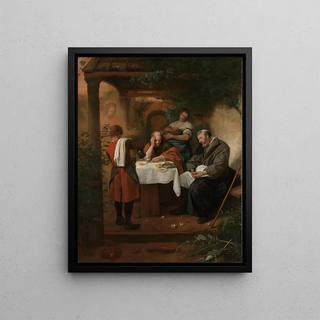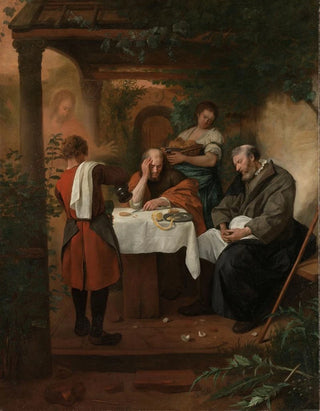Art print | Supper at Emmaus - Jan Steen


View from behind

Frame (optional)
Souper à Emmaüs - Jan Steen – Engaging Introduction
In the vibrant world of 17th-century Dutch painting, the artwork "Souper à Emmaüs" by Jan Steen stands out for its narrative richness and lively atmosphere. This iconic scene, highlighting a key moment in Christian tradition, depicts the encounter between the resurrected Christ and two of his disciples, thus revealing the very essence of faith and revelation. Steen, with his unparalleled talent, manages to capture not only the moment of divine recognition but also the intimacy and conviviality of a shared meal. The art print of this masterpiece invites viewers to immerse themselves in a world where every detail matters, where light dances on faces and objects, and where human emotion blends with spirituality.
Style and uniqueness of the work
Jan Steen's style is characterized by an exceptional mastery of chiaroscuro and meticulous attention to detail. In "Souper à Emmaüs," he uses light to guide the viewer's gaze toward the crucial moment of revelation. The face of Christ, imbued with serenity and wisdom, emerges from the shadows, while the disciples, frozen in expressions of surprise and wonder, embody the astonishment of rediscovered faith. The table, richly set, is not merely a decorative element but a symbol of communion and humanity. Every object, every gesture, is charged with meaning, demonstrating Steen's ability to transform an ordinary scene into a lively tableau where everyday life mingles with the sacred. Thus, the artwork becomes an invitation to reflection, contemplation, and awe.
The artist and his influence
Jan Steen, born in 1626, is often regarded as one of the masters of genre painting. His ability to tell stories through his paintings left a mark on his era and continues to influence contemporary artists. Steen does not merely depict scenes of daily life; he infuses them with moral and social dimensions, offering a subtle critique of the customs of his time. His influence extends beyond the borders of the Netherlands, inspiring generations of artists across Europe. "Souper à Emmaüs" is part of

Matte finish

View from behind

Frame (optional)
Souper à Emmaüs - Jan Steen – Engaging Introduction
In the vibrant world of 17th-century Dutch painting, the artwork "Souper à Emmaüs" by Jan Steen stands out for its narrative richness and lively atmosphere. This iconic scene, highlighting a key moment in Christian tradition, depicts the encounter between the resurrected Christ and two of his disciples, thus revealing the very essence of faith and revelation. Steen, with his unparalleled talent, manages to capture not only the moment of divine recognition but also the intimacy and conviviality of a shared meal. The art print of this masterpiece invites viewers to immerse themselves in a world where every detail matters, where light dances on faces and objects, and where human emotion blends with spirituality.
Style and uniqueness of the work
Jan Steen's style is characterized by an exceptional mastery of chiaroscuro and meticulous attention to detail. In "Souper à Emmaüs," he uses light to guide the viewer's gaze toward the crucial moment of revelation. The face of Christ, imbued with serenity and wisdom, emerges from the shadows, while the disciples, frozen in expressions of surprise and wonder, embody the astonishment of rediscovered faith. The table, richly set, is not merely a decorative element but a symbol of communion and humanity. Every object, every gesture, is charged with meaning, demonstrating Steen's ability to transform an ordinary scene into a lively tableau where everyday life mingles with the sacred. Thus, the artwork becomes an invitation to reflection, contemplation, and awe.
The artist and his influence
Jan Steen, born in 1626, is often regarded as one of the masters of genre painting. His ability to tell stories through his paintings left a mark on his era and continues to influence contemporary artists. Steen does not merely depict scenes of daily life; he infuses them with moral and social dimensions, offering a subtle critique of the customs of his time. His influence extends beyond the borders of the Netherlands, inspiring generations of artists across Europe. "Souper à Emmaüs" is part of






